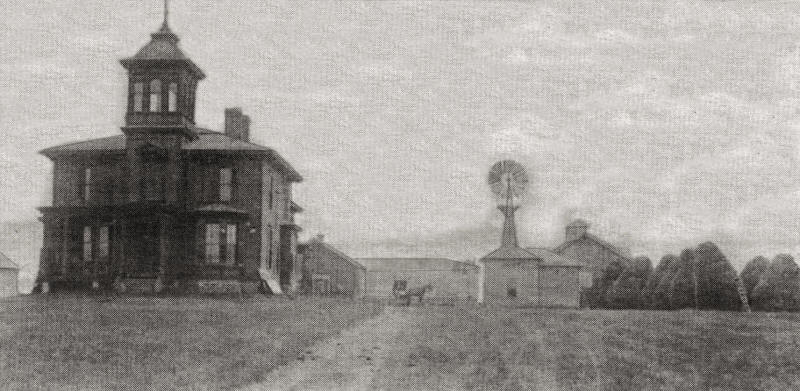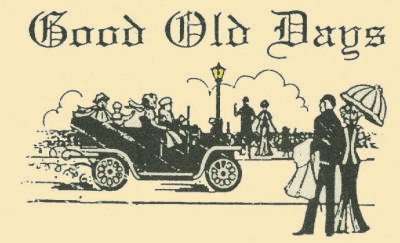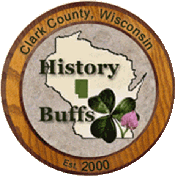|
|
|
Clark County Press, Neillsville, Wisconsin July 7, 2010, Page 11 Contributed by "The Clark Co. Press" Transcribed by Dolores (Mohr) Kenyon. Index of "Oldies" Articles
Compiled by Dee Zimmerman
Clark County News |
July 1915
There will be an all day Grove meeting held near the York Center Free Methodist Church Saturday, July 3, beginning at 10:30 a.m. Evangelist Sturdevant of Racine will preach. Mr. John Hinz of Milwaukee will sing. All are invited to come and bring your lunch. Rev. J. Crandall, Pastor
Chas Gaylord, who will have a sorghum mill in operation next fall, has the following sorghum notes: There are about 21 acres of cane sugar engaged for this season.
A new constitution was adopted last week by the voters of Denmark and signed by the King, which gives Danish women the unlimited right to vote.
Company A, 65 strong will leave Saturday morning at 8:30 for Camp Douglas to participate with the balance of the 3rd Infantry in the annual encampment and maneuvers. During the past year several additions have been made to the organization. A machine gun company and a supply company have been added. Among the entertainment features for the men, are band concerts every evening and a large Y.M.C.A. tent where writing material and plenty of good reading matter will be found. As it has been ordered that all organizations must go into camp with full complement of officers and men, it is hoped that firms and individuals having men in their employ who are members of the National Guard will arrange to let them off for the week for camp.
At a barn frame-raising at Ernest Hemps last week the scaffold gave way when a crew of men was putting on the purlin plates, sending the men to the ground among the wreckage. D. H. Rosenberg had a broken arm; the following men also received injuries: Ben Dux, Ferd Grap, Robert Schlinkert, Ed Schwellenbach, Charles Wagner, August Wagner, Leonard Schultz and Paul Hagedorn.
August A. Riedel of the Town of Grant was a Neillsville caller recently. Mr. Riedel came to Neillsville first in 1865 and has seen this country develop from a wilderness to a beautiful dairy region. He had charge of the old Neillsville Mills for nearly sixteen years when it ran by water-power.
Tuesday afternoon as Mrs. Kolar of the Town of Levis was coming into the city with a load of strawberries, her horse started to run as she came down the Dewhurst hill. The hold-back broke, which further excited the horse. With great presence of mind she kept her seat and pulled hard on the horse. When they turned the corner at the Merchants Hotel, the horse fell and struck one of the posts in front of the hotel, knocking the post down. The buggy was somewhat broken and the berries spilled, but Mrs. Kolar was not injured.
B. C. Youmans took down another bunch of cattle this week to his farm in Sherwood. Mr. Youmans recently traded his North Dakota property for a 300-acre farm in the Town of Sherwood and Jackson County and is stocking up the place.
Among interesting relics found in the old farm home of the late George Newcomb is a marking iron of Hewett & Woods. This iron is made like a hammer with certain letters or characters on the face, which when struck upon the end of a log left an imprint that identified the log when it floated with thousands of others down the river to the sawmill booms at La Crosse. These marking irons were very useful tools in old logging days, but are out of date now in this locality.
Would it not be worth while to preserve many of the old relics still stored away in attics of old settlers homes so as to link bygone days with future years? Such articles as for instances were found in the Newcomb home in Weston are not simply trash; they have historical value. They can speak as no living tongue can speak of olden times and early days; they can tell how far along the road to modern civilization we have come and mark well the stages through which the community has struggled in its way from pioneer life to the comparative luxury of today. Indeed they have a highly moral value to the present generation in showing how people lived and were happy under simple and primitive conditions, and that so called modern improvements are not absolutely necessary to the highest type of home joys. Then why not save some of those relics in some central historical collection where they may be seen.
(Now nearly 100 years later, the same mistakes are still being made; not saving relics, writings or other evidences of the past generations-eras within our community. The needed interest in doing something about it isnt enough. D.Z.)
Buy famous White Diamond Flour at $6.60 per barrel for a limited time only at the Big Store.
Two carloads of cheese and one carload of butter comprised the regular weekly shipments going out of Thorp during the past two months. The present year will eclipse all past records.
Landlord Bradford of the Merchants Hotel plans on serving warm biscuits with honey to his hotel guests in the near future. He started with a swarm of bees and last week a new colony swarmed from the old hive, which he secured in a new hive an now has them busily at work.
Mr. Raymond B. Colby and Miss Grace E. Visger both of Loyal were united in marriage at the home of the bride July 15. The Loyal Tribune thus speaks of the couple:
The bride is a charming and popular young lady and has a large circle of friends. She is the daughter of Mr. and Mrs. H. W. Visger of the Town of York and since graduating from the local high school has been teaching in this vicinity. The groom is the youngest son of Mr. and Mrs. B. W. Colby. He has a host of young friends and is a young man of sterling worth.
The young couple will make their home in Loyal.
July 1945
J. L. Neverman is closing out his business on the main street of the Old Home Town. He has been at it 38 years; the longest of any retailer presently active in Neillsville. Surveying the local scene, he could recall only one man now in business who antedates him, and that is J. F. Schuster.
Mr. Neverman has spent the entire 38 years in one location, a frame buiding belonging to Judge O. W. Schoengarth. When he started up there he had capital of $96, money, which he had earned and saved in a logging camp. He started out to run a coffee and tea store and the name of the business, to the very end, was the Neillsville Tea & Coffee Store. But that name and that policy were presently lost from sight. It was very soon referred to as Nevermans Grocery.
With only $96 to go on, and with tea and coffee to stock, whether or not, there wasnt much left for trimmings. So when a salesman came along and was given a small order for crackers, and only crackers, he slammed his book shut and went away from there. Mr. Neverman didnt, nor did he ever buy crackers, or anything else, from that source thereafter.
Various local men had no confidence in Mr. Neverman sticking it out and they told him so. With $96 in capital and virtually no experience, the prospect was nothing to brag about. But other salesmen were more accommodating than the cracker gentleman. When they trusted J. L. Neverman, they always got some money on account, even though he might not be able to pay it all. The result was that he kept his credit good.
Mr. Neverman intends now to catch up on his fishing and resting. He has quite a distance to go in that behalf, for he ran the old-time kind of store, which kept open practically always. Whether it was Sunday or a holiday, there was always the opportunity to fill a need, emergency or otherwise, by trying at Nevermans. That meant a confined life, with virtually no ply in it. So Mr. Neverman now plans to make up his play for 38 years.
Surrounded by empty shelves and the impediments of a business closing out, Mr. Neverman had his misgivings. Could he turn from the habits of 38 years and form new ones? Could he really play, or had he forgotten how? Then there was a certain loneliness and homesickness, in turning from the old ways.
The U. S. Third Army Division soldiers in Salzburg, Austria, found more than four and one-half tons of gold, which had been hidden on order of Nazi Foreign Minister Joachi von Ribbentrop.
The hoard, valued at $28,000,000 was in the form of British, American and Italian coins and in blocks. It was dug up by the soldiers of the Third Division from beneath the house of the former mayor of Bad Gasten and a nearby building. It had been buried three feet deep.
Capt. Wesley Stookey, a prisoner of the Japanese for three and one-half years, is now reported to be in Fukuoka prison camp, island of Honshu, Japan. He has been moved three times and his whereabouts have been unknown for a full year. Hence his father, D. D. Stookey, was greatly relieved to have his present address from the office of the provost marshal in Washington. Letters of no more than 24 words are permitted and the Captain is anxious to hear from friends.
Harold W. Goetsch, son of Mr. and Mrs. M. C. Goetsch of Colby, found his way for five days through Germany without being caught. On the fifth day he was a nabbed, just as he was crossing the border into Holland. Sgt. Goetsch was on a bomber, which on November 2, 1944, bombed the Luena Oil factory at Mercersburg, Germany. Their plane was badly hit by flak and went down in flames. All of the crew, including Sgt. Goetsch bailed out. Sgt. Goetsch spent five months in a German prison camp and was liberated by the Russians April 31 (30). He holds the Air Medal with two Oak Leaf Clusters and the Purple Heart. He is credited with three major battles.
Harold Embke, recently released from the service, is having a siege of malaria. Those who think by buying war bonds, contributing to the various drives and so forth, that they have done a great deal toward the war effort might give a thought to fellows, who like this young chap, have given much, much more and in addition will suffer the after-effects for years. Something to think about isnt it?
As local members of the Red Arrow Division return to the Old Home Town, they bring a record of remarkable military service. Locally the men went out as members of the service Company. In their large relations, they were members of the 32nd Division, which claims more fighting than any other division of World War II.
It was three years ago, April 22, 1942, that a convoy of tall gray ships bearing the then untested 32nd, started out from San Francisco. What that division has done in those three years is now an important part of our countrys military history of World War II.
As the clock ticked out the anniversary date the division had amassed a total of 13, 030 combat hours. For 543 days out of the 1,095, which have elapsed since they sailed through the Golden Gate, men of the 32nd have been in line and committed to action.
That is more than half of the time the Red Arrow boys have been overseas and 44 per cent of the total time in which the United States has been in the present war.
In the three years of overseas service the men of the 32nd have piled up an impressive list of firsts.
They were the first full army division to sail from the United States in one convoy; they were the first American ground force to be airborne into combat; first army force to defeat the Japanese in the Southwest Pacific (the Buna Campaign); and the first to test and prove General Mac Arthurs famous bypassing tactics.
The Red Arrow insignia of the famous 32nd, which was authorized in recognition of the divisions victories in World War I, signifies that the division has pierced every enemy line it faced, a tradition that has been upheld from the Hindenburg line of World War I to the various Yamashita lines of World War II.
(Veterans of the 32nd Red Arrow Division, and many of those who served in the navy, marines, coast guard and air force during World War II were gone from home three to four years, a long time. D.Z.)
Herbert Tubby Lowe has bought the Hamilton hotel building on Seventh Street, corner of Clay. The Hamilton building, which was long used as a hotel, has been vacant of late. Mr. Lowe intends to eventually remodel the building for living apartments. At present it will be used for furniture storage.
When more than 100 different articles made from feed bags are displayed by one Green County homemaker group, it is easy to imagine how many homemakers throughout Wisconsin are relying on flour and feed sacks to provide sturdy cotton material for household articles, clothing, even dresses.
Mrs. Margaret Mc Cordic, home management specialist at the University of Wisconsin, recommends the following method for bleaching the sacks. Rinse the sacks in cold water. Rub naphtha soap on the printing. Then dampen the print with kerosene, roll up tightly and let the kerosene soak in overnight. In the morning, wash in heavy suds and warm water until as much of the print as possible is removed. For stubborn paint, use turpentine.
(Are there some of you who remember wearing dresses or aprons made of flour and feed sack prints? Our mothers sewed some attractive clothing out of the sack prints by adding colorful buttons and rickrack. D. Z.) (I wore those kinds of dresses, petticoats and garter waists, made by mom. Dmk)
Brandt Food Market is the Home of Dependable Foods. Phone Red. 231
Pedersons Electric Shop, 110 West 5th St. Phone Blk 114

The G. C. Youmans farmstead was located one and one-half miles east of Neillsville along now Highway 10. It was the first Clark County farm to have milking machines for its dairy herd in circa 1910, when Neillsville people rode in horse-drawn wagons to the farm to view the new invention at work. Youmans, a very progressive farmer, introduced other new farming techniques, also. (Photo courtesy of Bill Roberts collection)
€€€€€€€€€€

